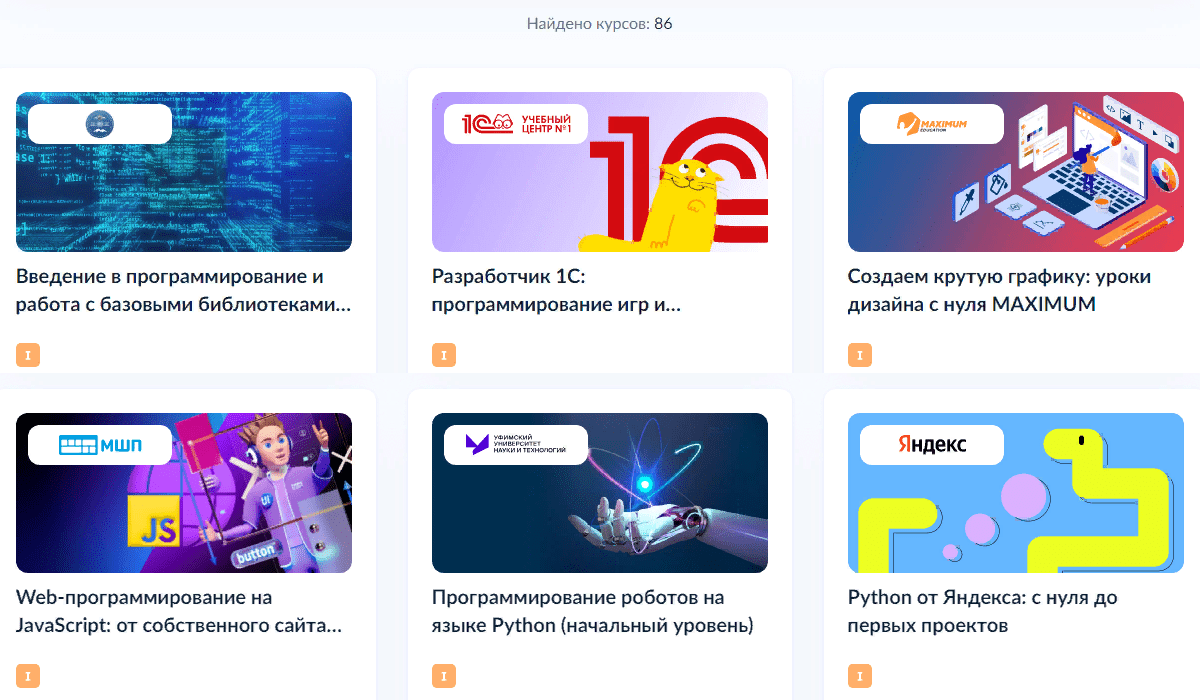While there is no programming discipline in schools, universities are not keeping up with the market, and the vast majority of specialists are graduates of online courses, the state is promoting its programs to obtain an IT profession. Let's look at where coding is being taught now and why online courses are no worse than public education.
Content ▼
What programming training programs are there?
Preschoolers
Junior High School
High school
High school, colleges and technical schools
Which programs do parents choose and which one is worth choosing
What programming training programs are there?
Interest in games from an early age can and should be directed in a useful direction – you can not only relax with them, but also study, and both options will easily captivate the child. Then such a hobby can grow into a hobby and a career, or just remain a useful habit and a sought-after skill.
There are a lot of programs and ways to teach coding to children, and we're not just talking about courses – these can be online resources, books, and even government programs. Let's analyze each age group in detail.
Preschoolers
Now the path of an IT specialist begins not with passing the Unified State Exam in computer science, but with kindergarten. They don't teach programming in kindergarten, but you can start from the age of three – we talked about this in a previous article – even a child who can't read can be occupied with toys that teach the basics of programming as a fun game.
You can thoroughly teach programming to a child from the age of four, for example, in the ScratchJr and Kodu Game Lab programs. They do not use text code, but a visual language – blocks with commands that can be dragged and connected like a constructor.

First, children learn visual programming, and only then they switch to regular code.
Each change affects the result, which the child sees immediately, which makes this format boring and exciting. Such a simple introduction to the programming environment will easily explain the basic structure of the code even to the youngest children.
So already at the age of 4-6 years, a child can:
- form an idea about programming and master its basic principles;
- find out what an algorithm is and learn how to work with it;
- master visual programming;
- create minigames and cartoons on your own.

Programming teaches the child to immediately look for solutions to problems and not focus on failures.
Let's summarize. What does programming give a preschooler?
1. The development of thinking. By programming, the child develops logic and the ability to quickly find solutions to any problems, and doing this in a group with other children – the ability to work in a team.
2. Useful leisure time. All training takes place in a playful way, and the child can be occupied with educational games and riddles with funny robots, with which he will definitely not get bored.
3. A new way of self-expression. Creativity is an integral part of any child's growing up. Someone draws, someone builds castles from constructors, and someone creates their own projects using code.
4. The foundation for future knowledge. The child will already know some basic principles and programs before starting more narrow courses. The computer and its capabilities will not be new, and learning will go easier and faster.
Examples of courses:
- CODDY Programming School: "Programming for the youngest"
Age: 4-6 years old
Format: online and offline
Duration: from 80 hours depending on the rate of assimilation of the material
A course on visual programming in ScratchJr, teaching the basic principles of code. During the course, logical and creative thinking, communication skills, the ability to read and count, and independence are also pumped – all in order to prepare the child for school and work with text code.
Elementary school
There are no government programs or school subjects for elementary school students yet, and here additional courses come to the rescue again. Here the choice is already wider: the child can continue to create games already in the usual Scratch or Tynker, engage in robotics with designers or learn cybersecurity.
After mastering any of these courses, you can start learning real programming languages - the base is already fixed, and it's time to move on to something more serious.

Step-by-step and systematic training is more effective than a one-time course.
What does programming give to a junior high school student?
● All previous bonuses. The child continues to develop creatively and improve his analytical skills, spending time not playing games, but creating them. New knowledge is layered on the previously obtained base, and training is more effective.
● Making it easier to learn English. Commands in programming languages are based on English words, and by this age the child will have accumulated some vocabulary. And there is nowhere without English now, especially in the IT field, which has long reached the international level.
● New friends. The guys are moving to a new level of working with programs and can share their projects with each other, as well as team up and create new things together. Even if the course is online and individual, there will definitely be other young programmers at the school with whom you can discuss your projects.
Example of courses:
- CODDY Programming School: "Minecraft: An Introduction to Artificial Intelligence"
Age: 7-10 years old
Format: online and offline
Duration: 8 months, from 64 hours
Neural networks are our future, and they are already gradually penetrating into all areas of our lives. Working with them will soon be in great demand, and you can start studying them with your favorite game. In this course, children program their virtual world, and by the end of the course they write their first program in JavaScript
Middle school
When the child is confident in the computer, and the basic concepts have already been fixed, you can start coding in classical programming languages. This time, it's not just games and cartoons: the focus can be shifted to other popular areas, such as website design, mobile app development and neural network creation.

High School – it's time to think about your future career.
At this stage, a student can choose almost any IT field and study it not only because they like it, but also in order to monetize it in the future.
While the child is not worried about the final exams, the parent thinks about them – and can cast a bait on the choice of the exam in advance, introducing the child to programming.
Reasons to program for a high school student (relevant for high school students as well):
● Career guidance. The idea of admission looms on the horizon, which often baffles schoolchildren. It is worth starting from the choice of future education based on the skills that the child received before, and programming in the arsenal of skills will help make this difficult choice.
● Portfolio. The child is already doing complex independent projects that can go into his future portfolio. It's still a long way to the professional level, but even with the existing set of skills, you can find a side job or participate in someone else's big project.
Example of courses:
- CODDY Programming School: "Frontend Developer"
Age: 11-14 years old
Format: online and offline
Duration: 9 months, from 72 hours
The website development course is a very popular IT profession now because almost no business can do without its own website or application. The child learns to write in HTML, CSS and JavaScript, masters Adobe Photoshop and creates several of his own websites.
High school, colleges and technical schools
To enroll in an IT specialty now, you need to know and be able to do much more than 5 years ago - the competition for places at universities is growing every year. But in schools, even if there is a subject "computer science", they do not teach development, and the state has its own answer to this.
In 2024, the project "Code of the Future" is being launched for schoolchildren in grades 8-11 and students of technical schools and colleges. These are 177 free courses on programming games, websites, neural networks and other programs in 15 programming languages. All courses are held online and last at least 144 hours.

You can apply for public services right now – recruitment is open.
Program conditions:
- To start studying, you need to pass an entrance test. If it didn't work out, the student will receive a link to an online course for self-study programming;
- After successfully passing the test, the student enters into a free tuition agreement with the educational organization that provides the course;
- Upon completion of the program, the student receives a certificate of completion of the course.
This is a great opportunity to upgrade your knowledge for free and prepare for university admission. Maybe even the course that the child will take. But to participate in the project, you need certain knowledge – they don't teach from scratch here.
Example of courses:
- CODDY Programming School: "Game development in C++"
Age: 14-16 years old
Format: online and offline
Duration: from 3 months, from 24 hours
An advanced course in game development in one of the popular programming languages, where students master the game engine and develop several of their games on a cross-platform basis.
Which programs do parents choose?
There is practically no choice between government programs and programming courses now, so most parents turn to specialized schools.
The following criteria will be relevant for both options:
- Systematic. One course can give excellent results, but it is unlikely to make a professional out of a child. When signing up for a course, take a closer look at other, more in-depth ones in advance in order to continue studying in the same profile, if the child likes it. The best option would be if all courses can be taken at the same school.
- In-demand. Everything that is popular in the professional world and with children – Python, Minecraft, Roblox, game development, website design and Scratch as a starting point in coding.
- Designed for a specific age. The more precise the age range of the course, the better it is focused on the level of knowledge and perception of the child.

When choosing a course, first of all, start from the preferences of the child.
So, stage by stage, the child's brain develops along with the projects and ideas that it creates, by the end of school getting not only a skilled young specialist with a baggage of ready-made projects, but also a creative person who knows how to work with people and is able to quickly find the most creative solutions to any problems. These are the kind of professionals that are needed in the IT field.
Are there no programming schools in your city? Join the CODDY team – we help make IT more accessible for children.
Read also:
- The impact of learning programming on children's development
- What is networking?
- Online education in 2024: How to develop an online school now